Ecommerce has reshaped how we shop, offering unparalleled convenience and variety. However, this convenience comes with an environmental cost, from increased packaging waste to carbon emissions from shipping. Addressing these challenges, sustainable ecommerce practices present a pathway to mitigate these impacts while catering to the eco-conscious consumer. This guide outlines actionable steps for ecommerce businesses to embrace sustainability, from optimizing operations to engaging customers in environmental stewardship.
What Is Sustainable Ecommerce?
Sustainable e-commerce is defined by online stores committed to environmentally and socially responsible practices. These businesses aim to fulfill market demands with minimal adverse effects on the environment, specifically targeting the reduction of climate change induced by human activities and mitigating other forms of industrial environmental harm.
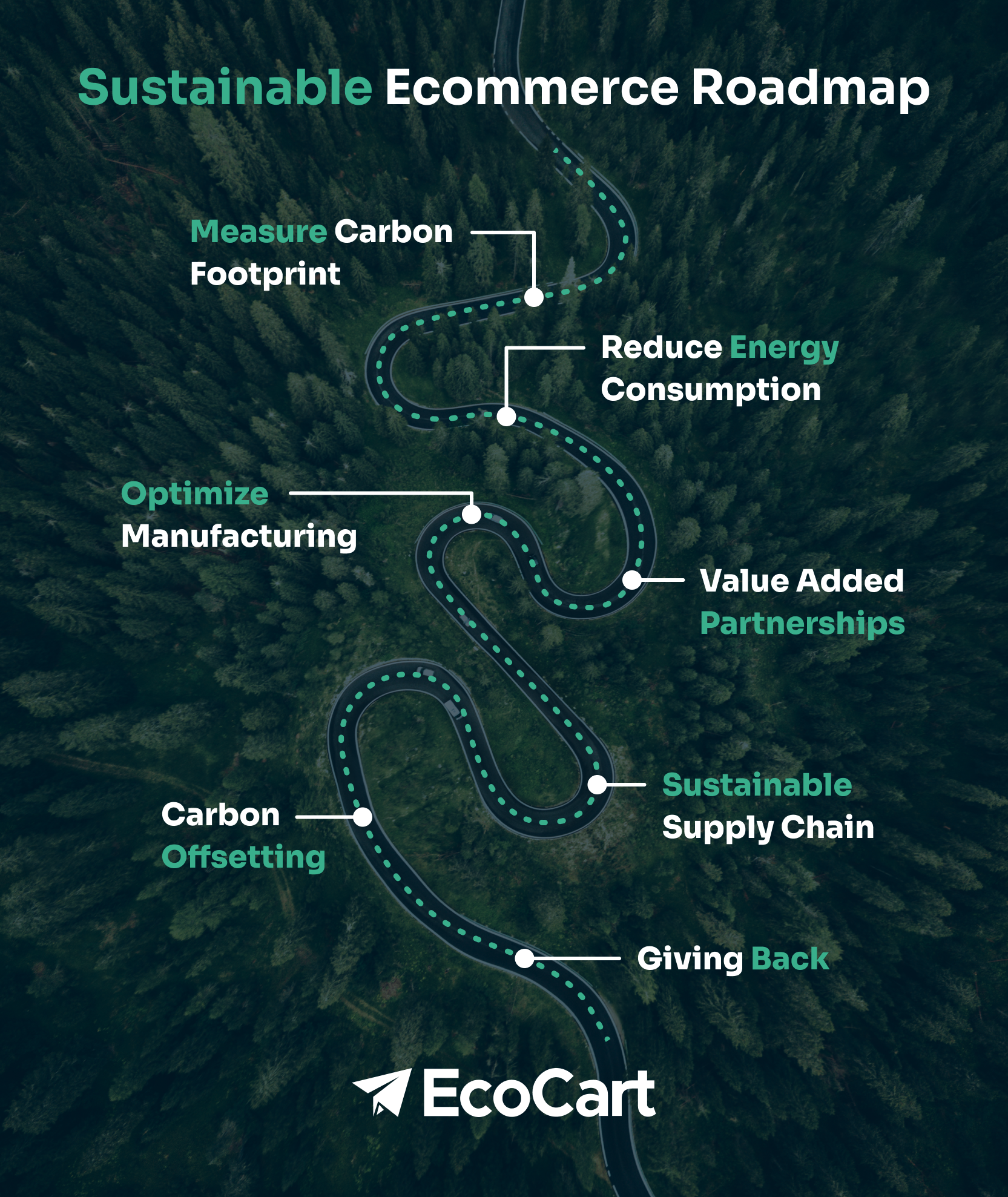
What Is A Sustainable Supply Chain?
A sustainable supply chain is an environmentally responsible supply chain that aims to reduce waste, conserve resources, and minimize pollution. A sustainable supply chain can include activities such as recycling, reducing the use of toxic materials, and using renewable energy sources. It also incorporates strategies to improve the health and safety of workers and communities, preserve biodiversity, and reduce emissions. The goal of a sustainable supply chain is to create a circular economy where resources are reused, refurbished, and recycled instead of discarded.
Benefits Of Sustainable Ecommerce For Your Business
Although the primary motive for sustainable ecommerce is largely focused on reducing the environmental impact of doing business, it’s essential to acknowledge that business benefits can be gained by making your ecommerce more sustainable.
You read that right, your business can actually grow by adopting sustainable ecommerce practices.
Okay, sure, but just how compelling is the call for sustainable ecommerce?
A recent survey found that 80 percent of respondents felt it was “important or extremely important” for organizations to develop environmentally conscious products. Further, 73 percent of global consumers claim they would “definitely” or “probably” change their consumption behavior to reduce environmental impact.
A recent study found that 66 percent of US adults are willing to pay more for eco-friendly products. This is significant because, although sustainable products often come with an increased upfront cost (on average, a 75-85 percent price hike over conventional products), the long-term benefits—including decreased emissions, improved customer satisfaction, and increased brand loyalty—far outweigh the initial investment.
And to consumers, sustainability trumps the cost of a product.
Further, 81 percent of global shoppers strongly believe businesses have a key role in improving the environment.
This sentiment opens a huge door of opportunity for ecommerce businesses worldwide.
Suppose you can adjust your business practices to meet the demand for sustainable ecommerce. In that case, you can differentiate yourself from the competition and appeal to ethical buyers who prioritize sustainability in their purchasing decisions.
Download our FREE ebook:

Why Sustainable Ecommerce Matters
According to a recent study, shopping in a brick-and-mortar store can be up to 60 percent more sustainable than shopping online.

*image courtesy of Simon
Yikes.
The study attributed the increased emissions of online shopping to
- The fact that ecommerce orders are often shipped long distances—sometimes across the country or the globe.
- Product returns are five times more likely when shopping online than in-store.
- Shopping online creates five times more emissions due to packaging such as corrugated boxes, bubble wrap, and the like.
- Same-day delivery or quick shipping also increased emissions, particularly due to increased air freight.
Another study backs up these findings. Packaging and returns are the biggest emitters for online retailers.
The good news is there’s plenty of room for improvement. Online shopping within the US can be up to 17 percent more carbon-efficient than shopping traditionally when sustainable practices are implemented.
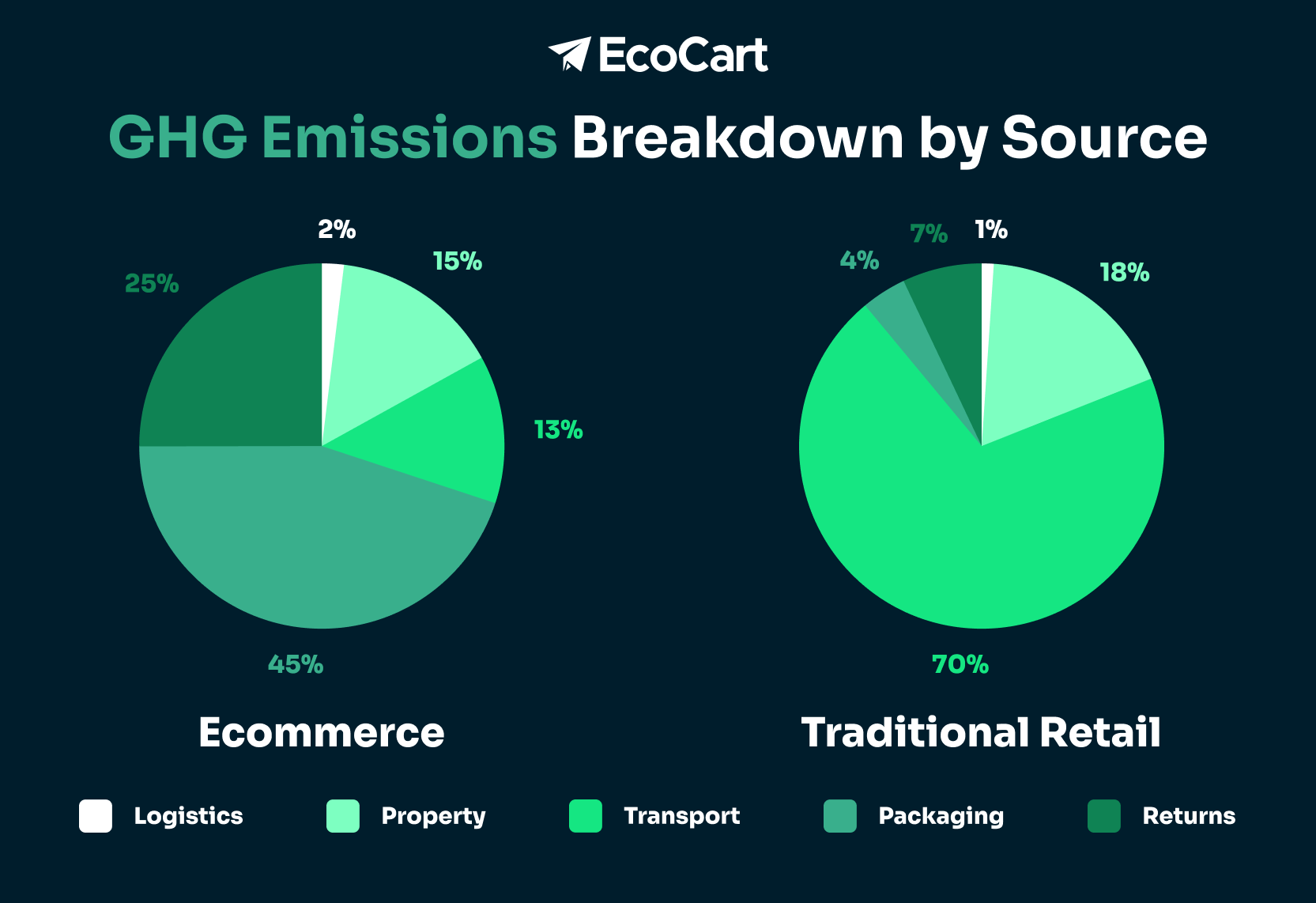
Learn more about eco-friendly delivery.
Read more astounding ecommerce statistics.
12 Sustainable Ecommerce Practices
1. Assess environmental impact with EcoCart’s LCA services
Understanding the environmental impact of your ecommerce operations is the first step towards a more sustainable business model. EcoCart’s Life Cycle Analysis (LCA) Services offer a comprehensive tool to analyze the carbon footprint of your products from production to delivery.
This detailed assessment highlights areas where your business has the most significant environmental impact, whether it’s in the materials used, the manufacturing process, or the logistics of getting your product to the customer.
For example, if the LCA reveals that a significant portion of your carbon footprint comes from shipping, you might consider optimizing your delivery routes or transitioning to eco-friendly packaging to reduce emissions.
Want to know where your business stands? Get your sustainability scorecard with our quiz:
2. Partner with eco-friendly suppliers
Navigating the transition to partnering with eco-friendly suppliers requires a deliberate approach, especially when you have existing supplier relationships in place. The goal is to align your supply chain with your sustainability values without compromising on quality or significantly increasing costs. Here are specific tips on what to look for in a supplier and how to validate their eco-friendly claims:
- Sustainability Certifications and Standards: Look for suppliers that have recognized environmental certifications. These can include the ISO 14001 (Environmental Management Systems), Fair Trade certification, the Global Organic Textile Standard (GOTS) for textiles, or the Forest Stewardship Council (FSC) certification for paper and wood products. These certifications provide a level of assurance that the suppliers are meeting specific environmental standards.
- Energy Usage: Prioritize suppliers who use renewable energy sources in their manufacturing processes. You can ask for their energy consumption records or any commitments to renewable energy targets.
- Waste Management Practices: Inquire about the waste management practices of your suppliers. Ideal partners should have comprehensive recycling programs, waste reduction initiatives, and possibly even zero-waste policies.
- Supply Chain Transparency: Seek suppliers who are transparent about their entire supply chain. This means they are open about where they source their raw materials and how they ensure these sources are sustainable.
- Eco-Friendly Materials: If your products involve raw materials, look for suppliers who offer alternatives with lower environmental impact, such as recycled materials, organic fabrics, or biodegradable components.
- Innovative Practices: Some suppliers might be engaging in innovative practices that reduce environmental impact, such as water-saving technologies in textile production or chemical-free dyes. These innovations can significantly reduce the ecological footprint of your products.
- Third-Party Audits and Reports: Credible suppliers often undergo third-party audits to assess their environmental impact. Request access to these reports to get an unbiased view of their practices.
- Community and Social Responsibility: Eco-friendly suppliers should also demonstrate a commitment to their community and employees, showcasing that sustainability goes beyond just environmental aspects.
To validate the information provided by potential suppliers, you can:
- Request documentation or proof of any certifications claimed.
- Ask for case studies or examples of their sustainability initiatives in action.
- Seek references from other businesses that have partnered with them.
- Consider visiting their facilities, if feasible, to see their operations firsthand.
By focusing on these specific areas, you can ensure that your move towards partnering with eco-friendly suppliers is both impactful and aligned with your sustainability goals. Learn how to conduct a supply chain audit.
3. Optimize packaging for sustainability
The most pressing issue with ecommerce is the amount of emissions generated by packaging, returns, and the waste generated when products are shipped. One way to reduce this is to opt for more sustainable packaging materials, such as recycled cardboard and biodegradable materials.
You can also look into offering a “no-frills” shipping option. This allows customers to opt out of receiving extras such as promotional material and product literature.
Here’s how to approach it:
- Streamline Your Package Sizes: Dive into your product assortment and pinpoint opportunities to trim down packaging. This isn’t just about using less material; it’s about rethinking the space your products occupy. For instance, if a gadget can fit snugly in a box half its current size, you’ve just halved your material use and possibly doubled the number of items you can ship in one go. This directly slashes your carbon footprint by reducing the cargo space needed for transportation.
- Embrace Eco-Friendly Packaging Materials: Transition to packaging that loves the planet back. This means swapping out the usual suspects (plastic and Styrofoam) for heroes like recycled cardboard, plant-based plastics, or even mushroom packaging. Imagine your product arriving in a box that, once discarded, breaks down harmlessly or even enriches the soil.
- Cut Down on Excess Layers: Examine each layer of packaging and ask, “Is this necessary?” Often, products are over-packaged for appearance, not protection. By choosing robust materials that guard against damage on their own, you eliminate the need for extra bubble wrap or plastic. This step not only conserves resources but also simplifies the recycling journey for your customers.
- Introduce Reusable Packaging Solutions: Forge a path for packaging that lives multiple lives. Consider cloth bags, sturdy boxes, or containers that customers can return, repurpose, or refill. This approach turns a single transaction into a loop of sustainability, where packaging gets a second act, not a ticket to the landfill.
- Demystify Recycling for Your Customers: Make it blatantly obvious how to dispose of packaging responsibly. Use symbols, simple language, and direct instructions to guide the recycling or composting process. When customers know exactly what to do with your packaging after unboxing, you elevate the chances of it being recycled correctly, amplifying your sustainability impact.
- Adopt a Less-is-More Design Philosophy: Minimalism isn’t just aesthetically pleasing; it’s eco-wise. By simplifying your packaging design to use fewer materials and less ink, you reduce environmental strain. Imagine sleek, no-frills packaging that speaks volumes of your brand’s commitment to not just the product but also the planet.
- Concentrate Your Products: If you’re in the business of selling liquids or powders, consider offering them in concentrated forms. This move can dramatically shrink your packaging needs and lighten the load during shipping. Picture a cleaning solution that’s just as powerful in a bottle one-third the size of its watered-down counterpart.
4. Streamline logistics for lower emissions
Adapting these practices allows for a significant reduction in logistics emissions, aligns operations with sustainability goals, and fosters customer involvement in eco-friendly initiatives:
- Optimize Delivery Routes: Utilize route planning software to find the most direct and traffic-free routes, reducing time on the road and cutting fuel consumption.
- Adopt Green Delivery Methods: Shift towards electric vehicles and cargo bikes for local deliveries to significantly decrease your carbon footprint.
- Consolidate Shipments: Encourage bundled orders to reduce the number of delivery trips, saving on fuel and packaging.
- Sustainable Warehousing: Adopt solar power and LED lighting in warehouses to slash energy use and emissions.
- Carbon Offsetting: Invest in carbon offset projects for emissions you can’t yet eliminate, like reforestation or renewable energy initiatives.
- Partner with Eco-Conscious Carriers: Choose logistics partners committed to sustainability, ensuring your entire supply chain reflects your eco-friendly values.
- Incentivize Sustainable Choices: Offer discounts or perks for customers choosing slower, more sustainable shipping options, promoting environmental awareness.
5. Transition to renewable energy
Making the switch to renewable energy is a powerful step in reducing your ecommerce business’s carbon footprint. By powering operations with solar, wind, or hydro energy, you significantly cut down on greenhouse gas emissions. This transition not only showcases your commitment to sustainability but also can lead to long-term cost savings on energy.
- Install solar panels on your warehouse and office rooftops.
- Choose green energy providers that supply 100% renewable energy.
- Invest in renewable energy credits to offset non-renewable energy use.
6. Enable carbon offset with EcoCart’s checkout widget
Incorporating EcoCart’s Carbon Offset Checkout Widget allows your customers to take part in your sustainability journey. By offering them the option to offset the carbon footprint of their purchases, you provide a tangible way to contribute to environmental projects.
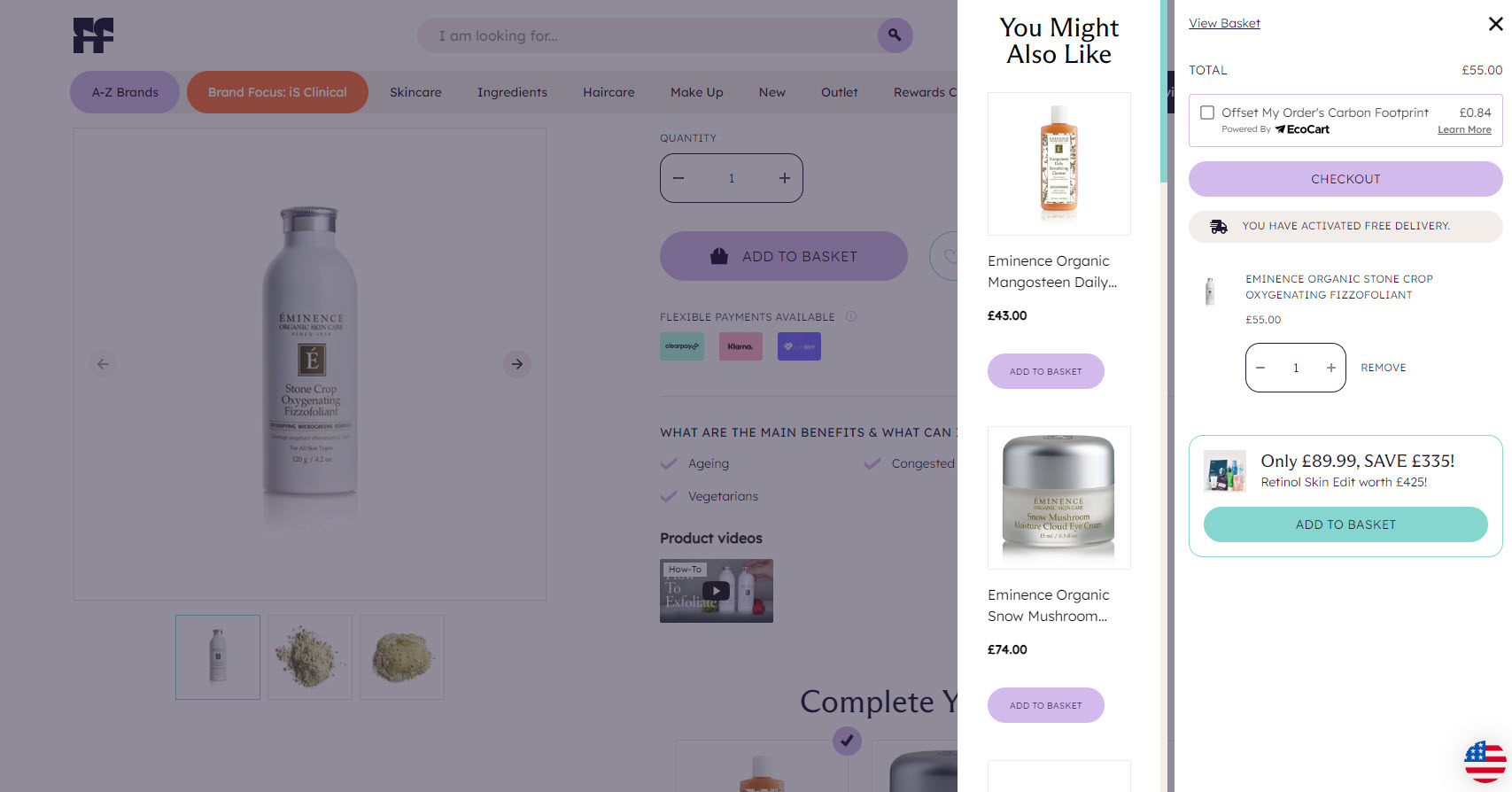
This feature enhances the shopping experience by aligning consumer actions with their values.
- Integrate the EcoCart widget at checkout for carbon offsetting.
- Highlight specific projects funded by the offsets to show impact.
- Offer incentives for customers who choose the carbon offset option.
7. Implement waste reduction initiatives
Waste reduction involves minimizing the use of resources and finding ways to reuse or recycle materials. Implementing these practices not only lessens your environmental impact but also resonates with eco-conscious consumers looking for responsible brands.
- Eliminate single-use plastics in packaging and operations.
- Set up recycling stations in your facilities for paper, plastics, and electronics.
- Encourage a digital-first approach to minimize paper use in offices.
8. Reduce the need for returns
Returns are costly, not only in terms of money but also in terms of resources used for delivery, packaging, and environmental impact. To reduce the need for returns, you should streamline your product page to help customers make well-informed buying decisions. Make sure also to include detailed product information and accurate sizing guides.
You can also offer virtual fittings, such as virtual shoe-fitting, to help customers get the right fit and prevent returns. Or create a product recommendation system that uses AI to suggest similar items that are more likely to be the right size or fit.
9. Educate customers on sustainable choices
By informing your customers about the eco-friendly aspects of your products and practices, you empower them to make conscious choices. This not only fosters a community of informed consumers but also strengthens your brand’s commitment to transparency and environmental stewardship.
You can do this by providing detailed product descriptions and sourcing information, as well as the environmental impact of the product. This could include where the item was manufactured, how it was made, the materials used, and any certifications the product may have.
- The Applia Product Information Standard (APIS) is an excellent resource for ecommerce businesses looking to provide detailed and accurate product information. This standard allows companies to share information about their products’ origin, materials, and certifications, making it easier for customers to make more sustainable purchases.
- HS codes are standard international codes that classify goods and services for tariff and customs purposes. Understanding HS codes can help you accurately classify your products and provide detailed product information. This can help customers make more sustainable decisions and promote sustainability within your ecommerce business.
- The EU Eco-Label program is a voluntary certification system that encourages the production and use of sustainable products and services. Companies must demonstrate that their products meet certain sustainability requirements to obtain the EU Eco-Label.
Continuing the effort to educate your customers on sustainable choices, expanding your outreach through digital platforms can further engage and inform your audience. Launching a blog or newsletter dedicated to sustainable living, eco-friendly tips, and the broader implications of environmental stewardship offers your customers a treasure trove of actionable information and insights.
Hosting webinars or workshops that explore the nuances of sustainability practices, environmental impact, and how individuals can contribute to a healthier planet serves as an interactive extension of your educational efforts.
10. Monitor progress with sustainability insights dashboard
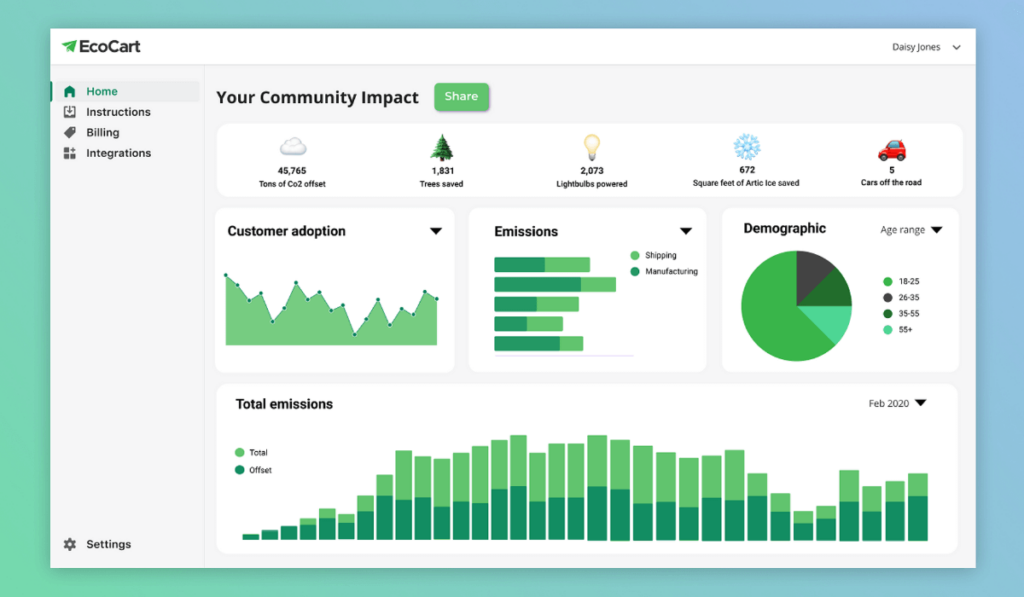
Leveraging tools like EcoCart’s Sustainability Insights Dashboard offers a clear view of your sustainability efforts and their outcomes. Monitoring real-time data helps in making informed decisions, setting realistic goals, and communicating progress to customers and stakeholders. This transparency builds trust and demonstrates your genuine commitment to making a difference.
- Track carbon footprint reduction through the dashboard.
- Set sustainability goals and share progress updates publicly.
- Use insights to inform future sustainability initiatives and improvements.
11. Resell or recycle your used merchandise
If you’re looking to reduce waste associated with selling used merchandise, you can use an ecommerce marketplace to resell your items to buyers looking for a good deal.
If reselling is not an option, then you can create recycling policies that help you reduce waste and make your ecommerce business more sustainable. Make sure your policies are clearly outlined and easy to understand.
It would be best to consider incentivizing customers to return or donate their used items to reduce unnecessary waste. Reusing and repurposing items is also a great way to reduce waste and give back to the community.
12. Update your brand’s mission statement
To ensure that sustainability is a top priority for your ecommerce business, you should update your brand’s mission to reflect your commitment. This is also a good time to create and publish a sustainability statement. This should include focusing on sustainability, reducing your environmental impact, and supporting like-minded causes.
Make sure to include specific goals and initiatives to help your customers better understand your commitment and give them a sense of trust in your brand. You should also clearly communicate your mission and update your customers about your progress toward your goals.
10 Examples of Successful Sustainable Ecommerce Businesses
Let’s look at some small to medium-sized ecommerce stores that have achieved just that.
SwagOz
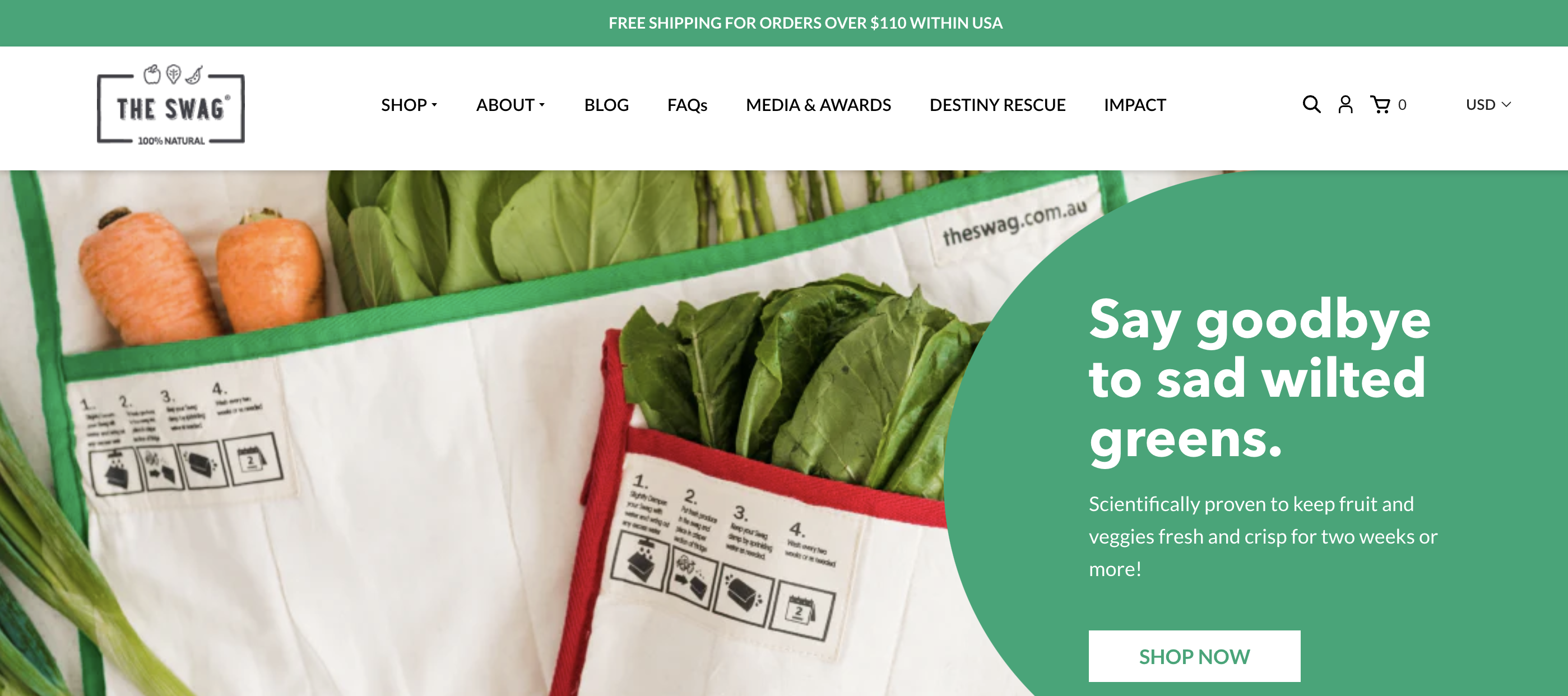
SwagOz is an Australian-based online store that sells a wide range of sustainable products like dish soap bars, non-paper towels, reusable makeup pads, and more. SwagOz, however, is most famous for its reusable produce storage bags called The Swag.
Swag bags have been scientifically proven to keep fruits and vegetables—stored within refrigerators—fresh for up to two weeks. Further, Swag bags are made from 100 percent compostable, toxic-free, and fair-trade cotton.
Biome

Biome is another Australian-based online store specializing in eco-friendly and sustainable living products such as natural skincare, reusable water bottles, eco-friendly cleaning products, and biodegradable cleaning tools.
This ecommerce business is dedicated to its sustainability mission and has pledged to continuously reduce its environmental impact. Biome also guarantees the products they sell are free from all known toxins, are cruelty-free, are made from natural fibers, and are long-lasting. Just another way that Biome is showing its commitment to sustainability.
Kind Coffee
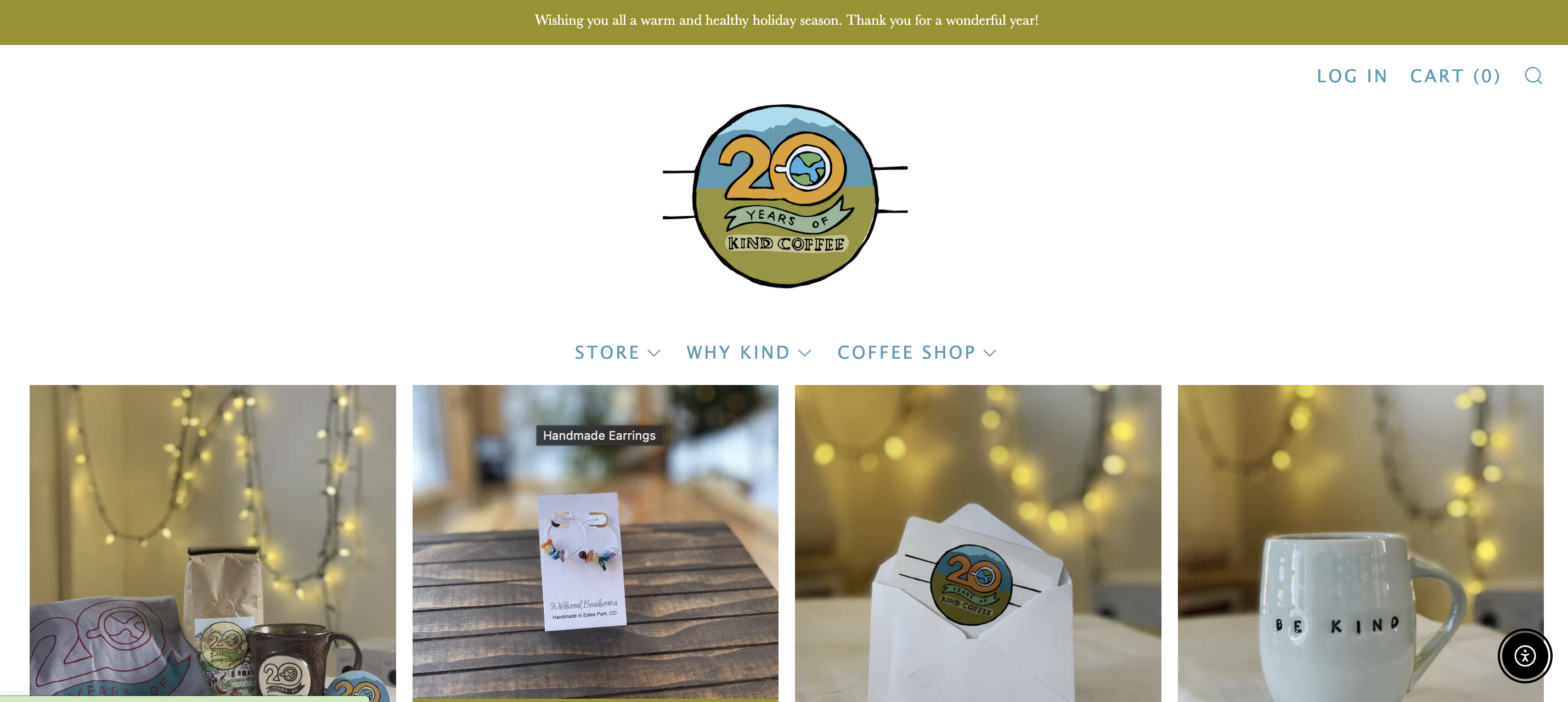
Kind Coffee is a US-based online coffee shop that sources ethically grown, single-origin coffee from some of the best smallholder coffee farms in the world. Every purchase from Kind Coffee is a part of a larger initiative to create sustainable livelihoods for coffee farmers.
This ecommerce business is pioneering sustainability in the coffee industry. Kind Coffee sells Fairtrade-certified coffee that is predominately organic, making it not only healthy for customers but also sustainable and environmentally friendly.
U-Konserve
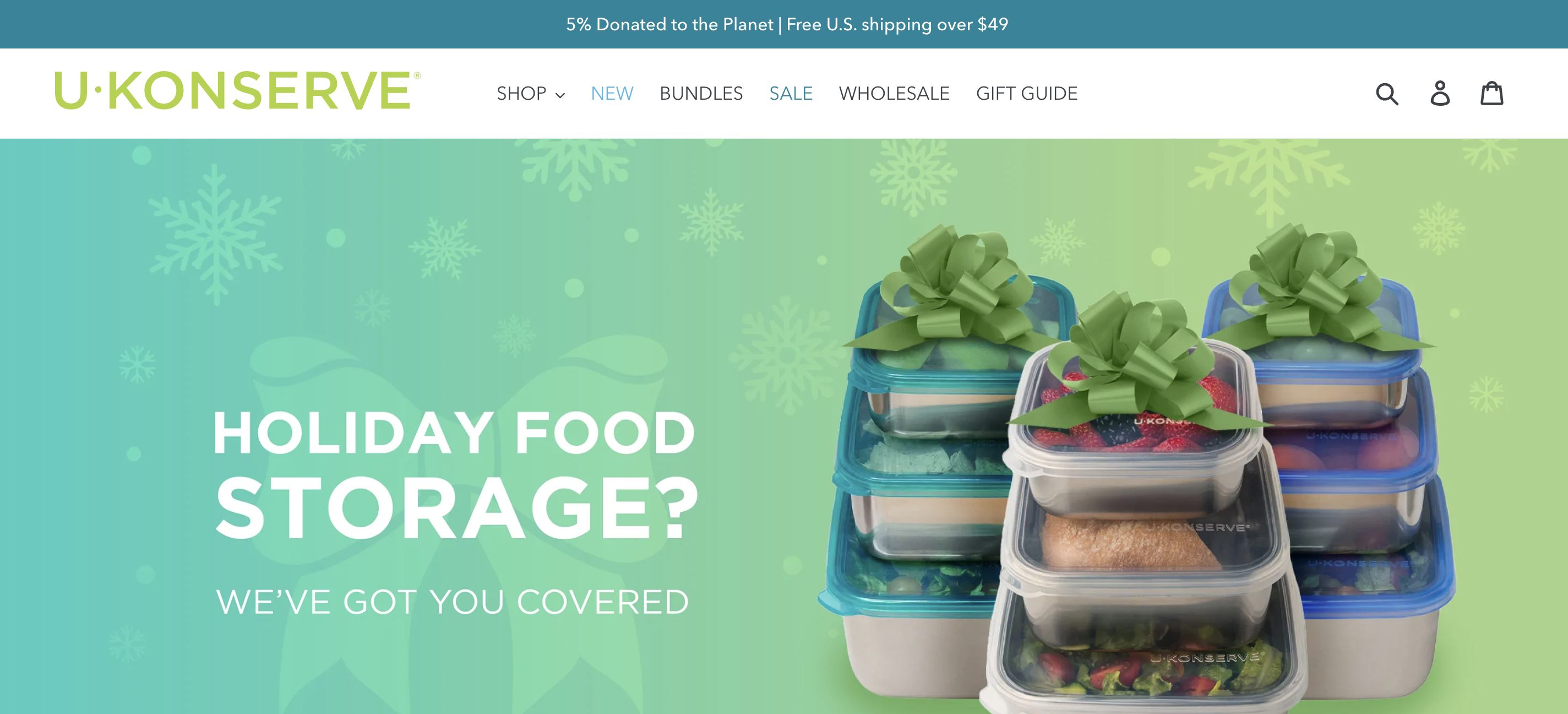
U-Konserve is another US-based online store specializing in sustainable food and beverage storage. They offer an array of products made from eco-friendly materials such as glass, stainless steel, and silicone.
U-Konserve is committed to reducing single-use plastic and making food storage more environmentally friendly. Not only does this ecommerce business offer reusable products, but it also encourages customers to consider the environmental impact of their purchases and to switch out plastic for more sustainable items.
Honeybee Wrap
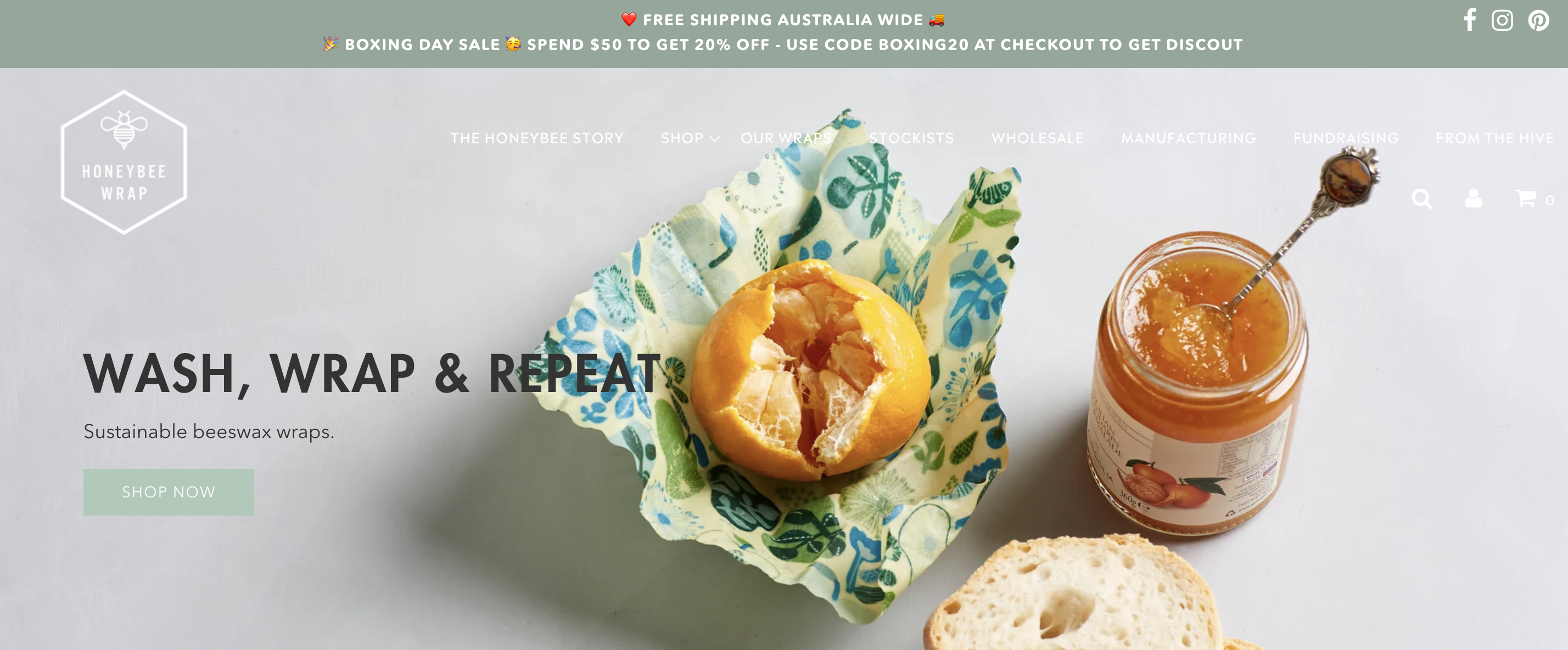
Honeybee Wrap is an ecommerce business specializing in reusable beeswax wraps. These wraps are a sustainable alternative to single-use plastic wrap and cling film, usually made from petroleum-based plastics, and instead are made from a combination of organic cotton, beeswax, and jojoba oil.
Honeybee Wrap is helping to reduce plastic waste and the emissions generated from the production of single-use plastic wrap.
PlanetBox
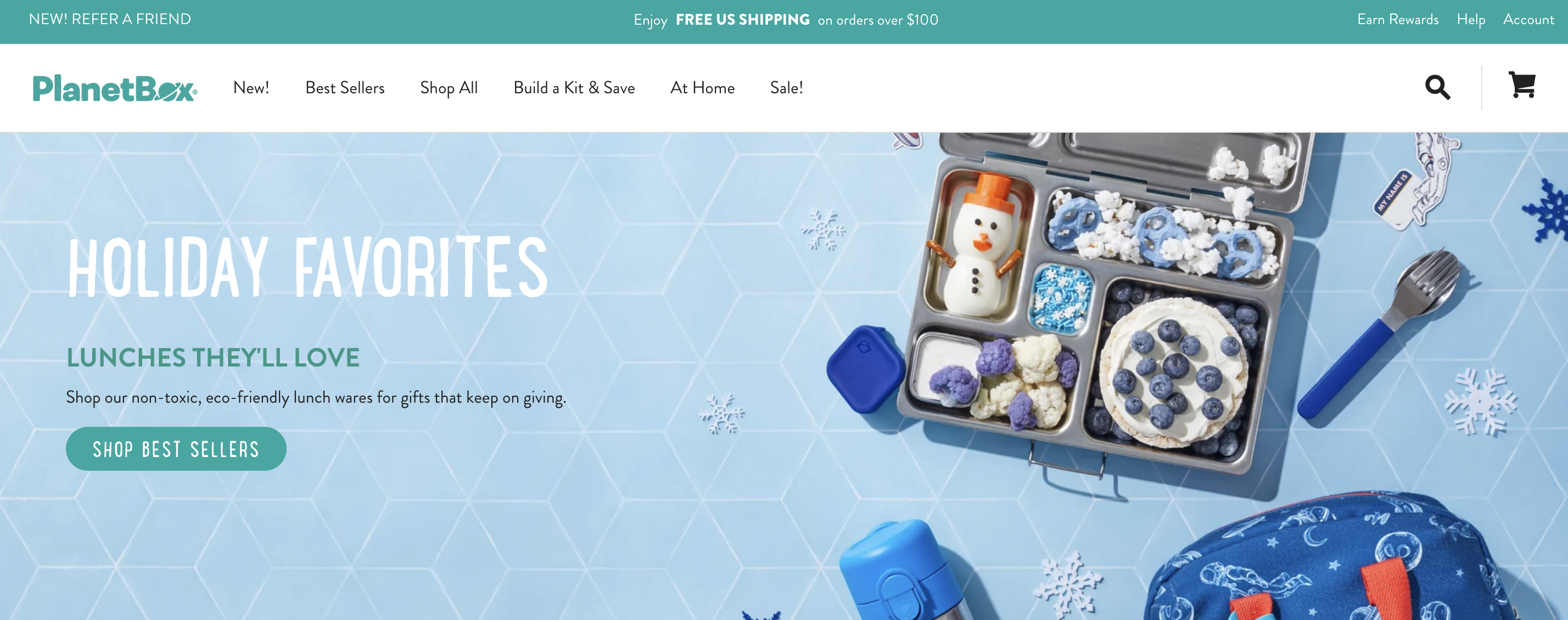
PlanetBox offers a range of reusable lunch solutions for adults and children. The company’s mission is to reduce the amount of single-use packaging and plastic waste worldwide.
PlanetBox sells lunchboxes, bento boxes, water bottles, snack boxes, and more. These products are made from sustainable materials such as stainless steel and food-grade silicone, making them safe for food storage.
Lousy Ink
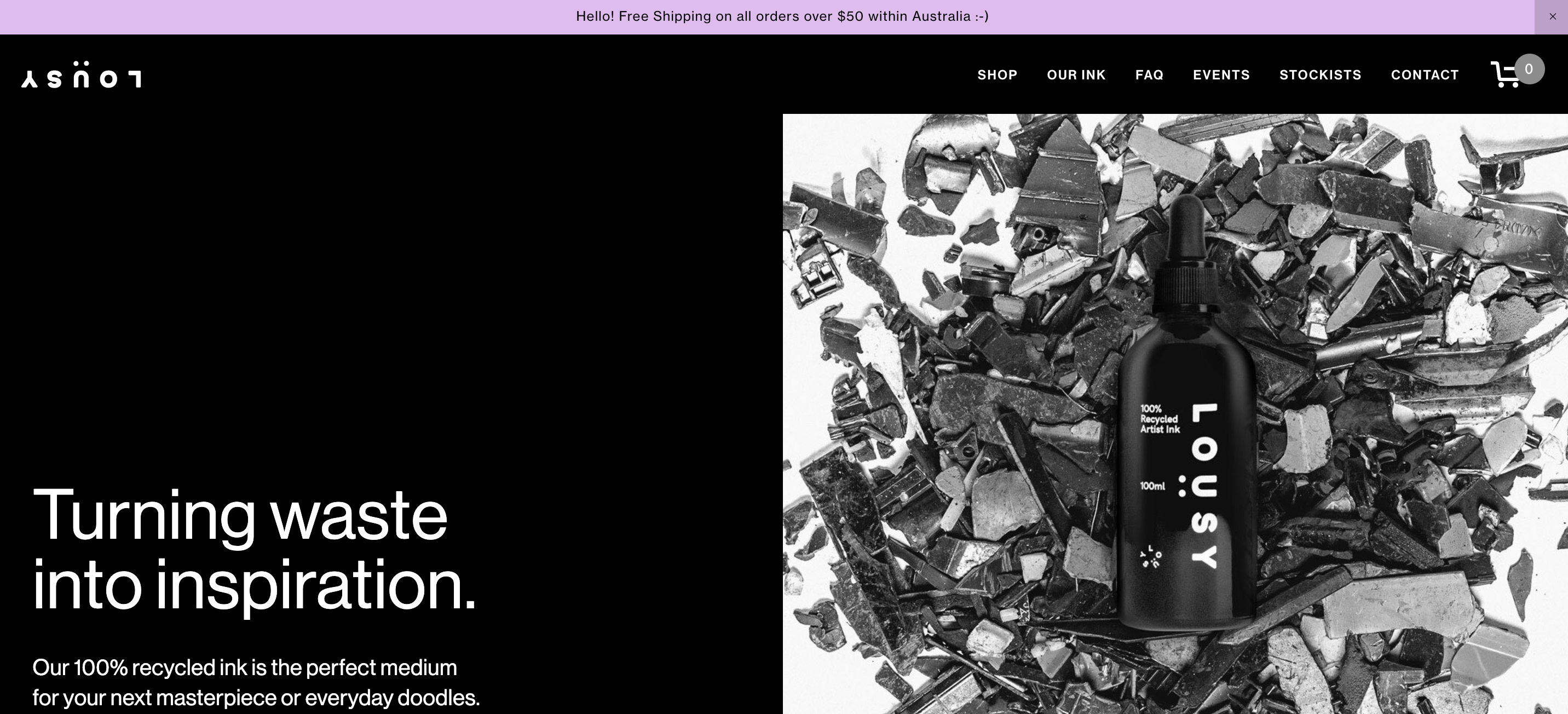
Lousy Ink is a great example of an ecommerce business helping to create a more sustainable future. The Melbourne-based company takes empty printer cartridges, crushes them, and repurposes the plastic into 100 percent recycled ink.
This is not only a sustainable way of shopping but also a creative one. The company’s ink is perfect for creating art, and users can access a range of colors and effects, all while reducing materials that would otherwise end up in a landfill.
Ecostore
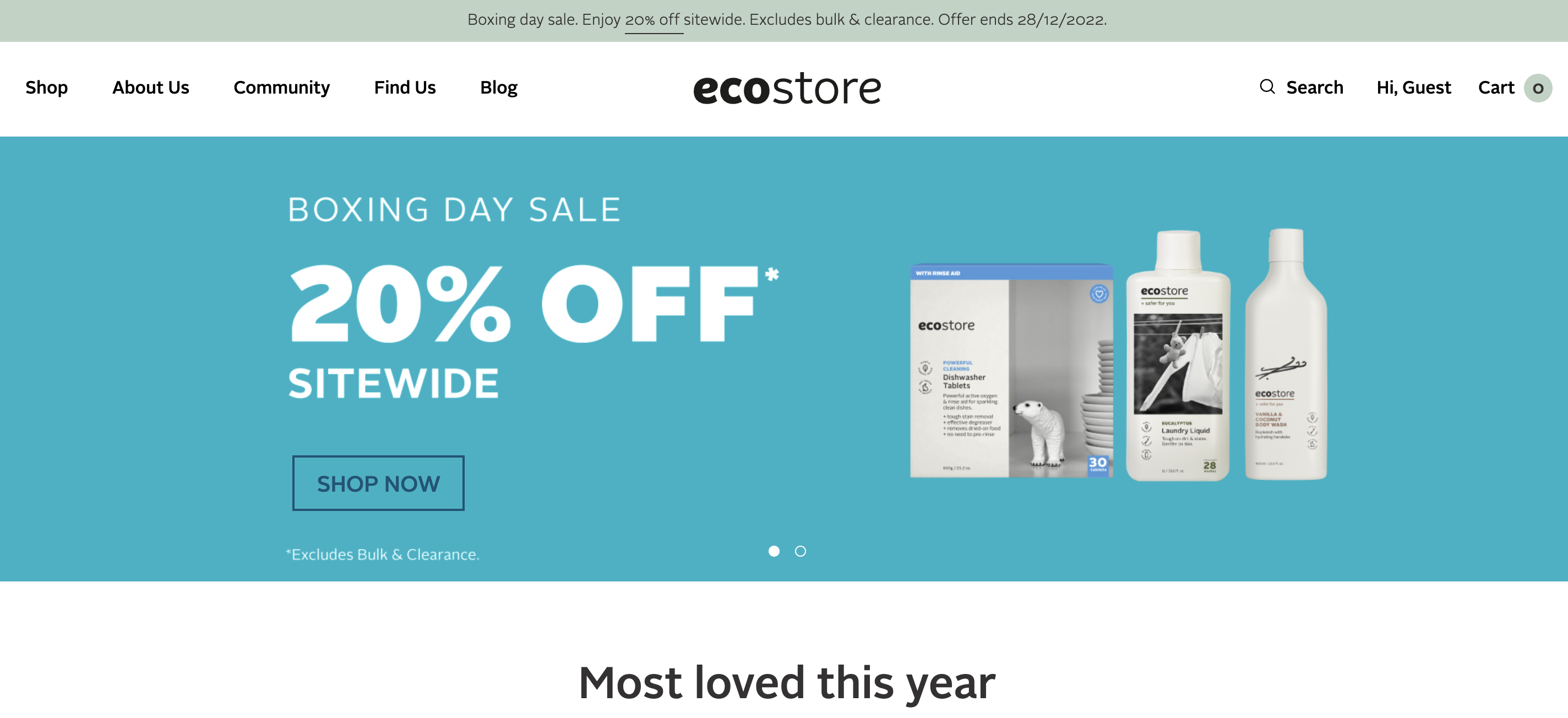
Ecostore is an online store from New Zealand that specializes in non-toxic, sustainable products. Their products, made in NZ but available here in the US, are free from nasty toxins and are made from natural and renewable ingredients. The company is always looking for ways to reduce its environmental impact, such as using recycled and recyclable packaging, solar energy, and planting trees.
Ecostore is leading the way in sustainability by showing people the power of natural and sustainable products. They are also partnered with the Live Ocean Foundation. An organization dedicated to restoring the biodiversity of our oceans, supporting marine ecosystems, and funding clean-up projects.
Flora & Fauna
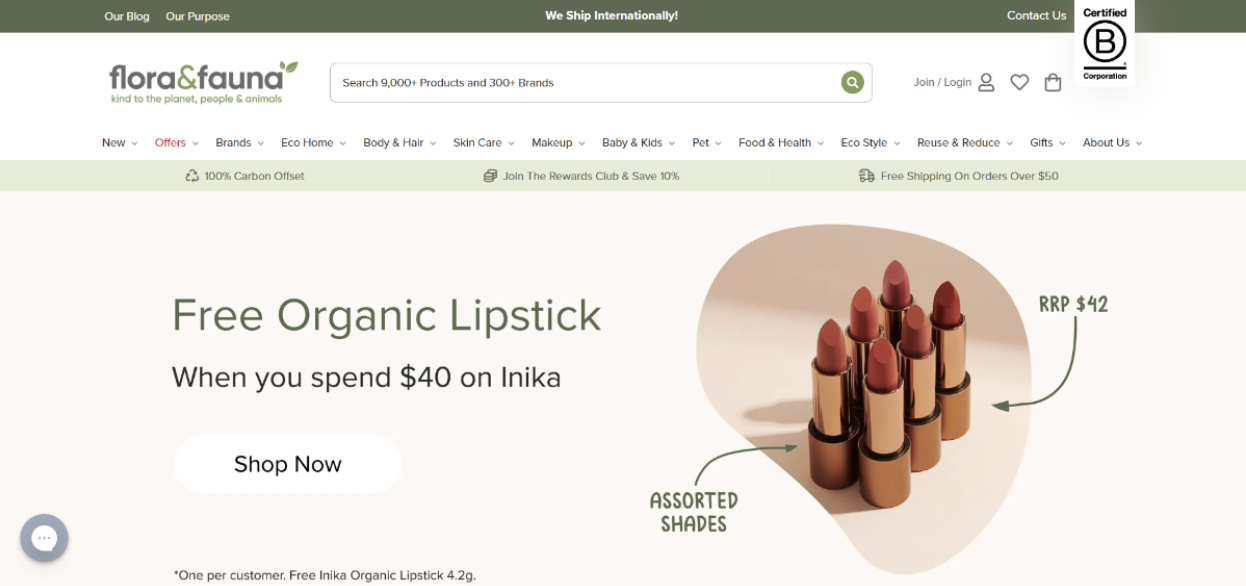
Flora & Fauna specializes in natural, vegan, and cruelty-free products. Flora & Fauna offers a wide range of products, including skincare, body care, makeup, food and drink, and lifestyle products.
This ecommerce business is committed to sustainability in all areas of its business. All their products are natural and vegan, and they are continuously looking for ways to reduce their environmental impacts, such as using eco-friendly packaging and plant-based shipping materials.
Avocado Green Mattress

Last but not least, Avocado Green Mattress is a US-based company offering premium mattresses made from natural and sustainable materials. The company offers mattresses made from organic and natural materials, such as cotton, wool, and natural oils.
Avocado Green Mattress is committed to providing its customers with a healthier and greener sleep experience. They are also dedicated to using sustainable and eco-friendly materials and processes for every mattress they make.
See How EcoCart Can Help Your Sustainable Ecommerce Business Grow
Sustainable ecommerce is becoming increasingly important. The advantages of sustainable ecommerce come from increased efficiency, reduced environmental impact, improved customer satisfaction, and increased brand loyalty.
With the right strategies in place, your ecommerce business can become more sustainable and reap the rewards of doing so.
Learn more about how we’ve helped thousands of online businesses drive growth through sustainability.



